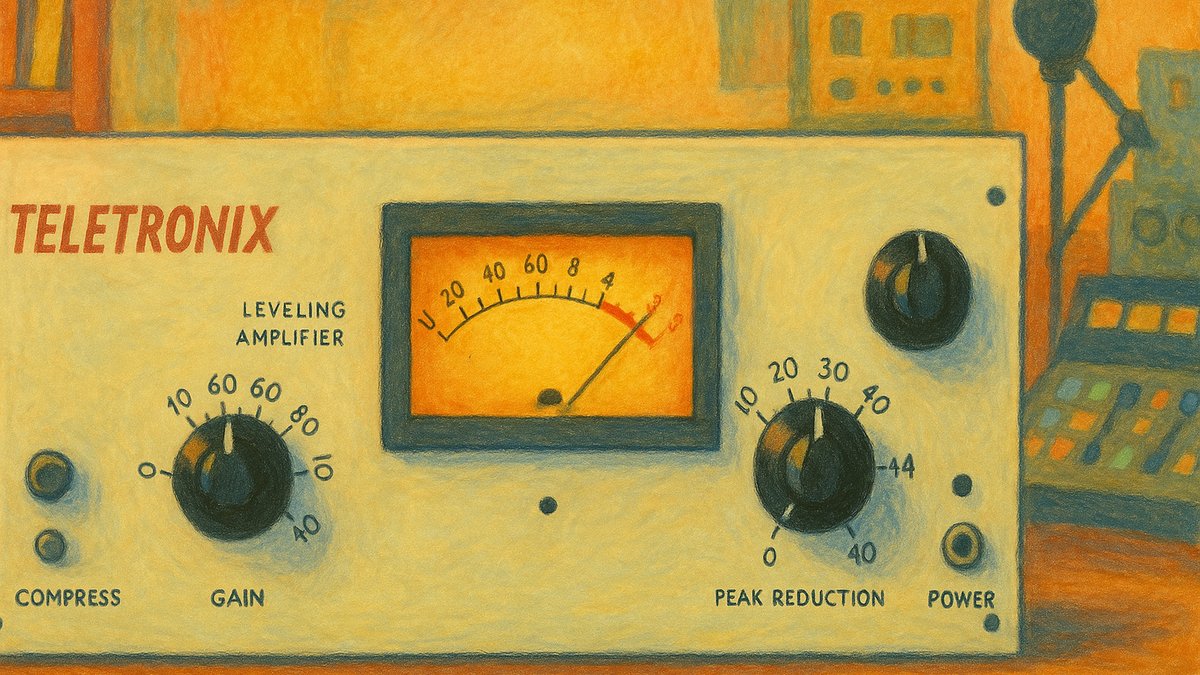
By Teddy Allmendinger
Posted 05/11/2025
In this article we are going to dive into compression! There are many different ways to compress an electric guitar and I certainly do not know all of them. I do however know a lot of them, and I’d be happy to expand upon some of my favorites for you. My workflow consists of using both analog and plugin compressors. I typically try to get some level of compression right on the front end (in the recording) and then I can use plugins to clean up/make more choices afterwards.
Use With Caution
I will start off by stating that compression can be overused and is not always necessary. We often feel obligated to throw them in the chain because they are shiny and cool and famous. I’ve found that this road leads to too much compression and too much compression leads to a mix not banging just as hard as it should. This stems from the idea that compression, at its core, is aimed at limiting dynamics. Certain signals can be absolutely demanding of this. For example, a funky guitar that has really fast transients? Then yes, let’s get a compressor going to smooth that out. Sometimes acoustic guitars played all big and bright can really drag a mix in a certain direction, often a compressor can help it sit back into its rightful place. However, if you have a driven amp that’s really pumping, there is already some natural compression that’s going on. Make sure to be cognizant of that before adding more external compression. Sometimes the natural thing IS the thing.
Compression Tip # 1: LA-3A
When I picture immediate satisfaction in the guitar compression world, I think of an LA 3A on a crunchy rhythm part. The 3A has a soft glue to it. It tucks the whole thing together without totally smashing or flattening it, yet allows the distortion to sit evenly but still feel like it’s breathing to some degree. In terms of where to begin, I would suggest starting at a 2:1 ratio with the gain reduction barely tapping 3-5db on the louder hits. The 3A is going to give some of the higher end a blooming sensation, especially when the signals break up and the distortion is kicking in.
Compression Tip # 2: Distressor
Another go to compressor is the Distressor. An excellent piece of equipment but I will say use with caution. For guitars I would keep it in Opto mode with a soft knee, slowish attack and auto release. This gets the Distressor to sort of behave like an LA2A but with a more modern crisp to it. Easy to compress too much with this guy though. Be careful!
Compression Tip # 3: LA-2A
This leads me to the LA2A. Obviously a holy grail for many reasons. I prefer it on drum overheads, but golly they kick total butt on guitars. Both acoustics and electrics can be grabbed comfortably by the 2A. The 2A loves a warm acoustic guitar in the same way that it loves a buttery blues solo. The mid-range harmonic production of a 2A is very saturated and very colorful for things like acoustics and warmer clean electrics. For acoustic, I would aim for about 3-5db of gain reduction on your peaks. Adjust your makeup gain as needed. Similar starting place for electric guitars too. It all really comes down to your ear. Pay attention to where the sound gets louder and quieter in your recording. Decide how drastic you want that moment to feel.
Compression Tip # 4: Compression? Are We Sure?
These three compressors are excellent places to start for really compressing any stand alone guitars. I’ve learned that compression isn’t even always just about compression. Often I will choose an analog compressor based on the color that it gives to the sound. Sometimes I don’t even care if it’s limiting my peaks very much at all. Often I will go into the DAW and hand compress my audio in effort to preserve my front end recording that I got. Compressors can also be seen as just different tone generators. The 1176 Blue Stripe is known for its silk and shine, while the LA2A is known for its warmth and size. These colors and textures are redeemable in their own right outside the actual use case of compressing a signal. I would urge you to just be aware of that and when you think you are just compressing a signal, you are actually changing the color of the sound as well. Be conscious of it and allow those moments to be choices.
Compression Tip # 5: Group Compression
Here’s my final note when thinking about guitar compression: A lot of the time I like to stack guitars anywhere from 4-6 times. This many layers allows me to really fill out the stereo field and create a wide, thick guitar sound. Once I have all these layers stacked and panned, then I apply compression. When I think about group compression I often leave behind the big, bold, colorful compressors like the ones I listed above. When I group compress I go right to a Smart compressor or an SSL bus compressor. Those things will glue it up and it will make you smile.
Cheers,
Teddy
